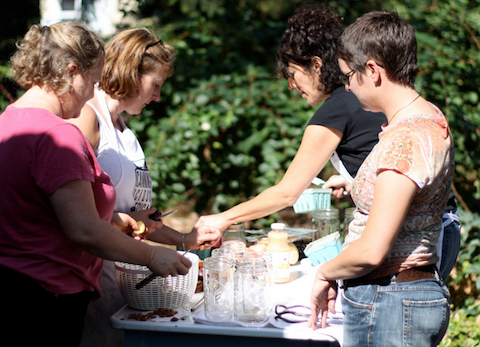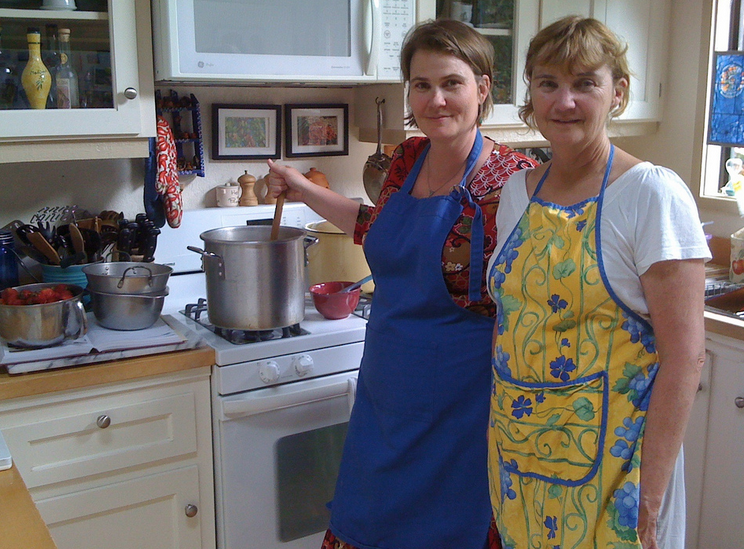The founder of Canning Across America offers some tips on gathering the right supplies, people, recipes and more for a great community canning session.
Recently, Shareable chatted with Kim O’Donnel, founder of Canning Across America, a collective of cooks, gardeners and food lovers interested in “putting food up.” We discussed the community aspects of canning and how farmers, sellers, neighbors and friends all contribute to, and benefit from, the canning process.
O’Donnel provided some helpful hints for hosting a canning session and directed us to this nifty water bath canning cheat sheet (she recommends beginners start with water bath canning as pressure canners requires a lot more knowledge).
The following guide is a mashup of O’Donnel’s practical wisdom, her friendly guidance, and tips taken from the cheat sheet. For more information check out Canning Across America’s Frequently Asked Questions page.

Yum! Freshly canned jam. Creative Commons photo by Shanna Trim.
Supplies
Before you even think about turning on the stove, gather everything that you need. This includes the essentials: food to be canned, jars, lids, rings, funnel, a big pot or kettle, jar lifter and lid lifter, as well as things that fall into the nice-to-have-but-not-necessary category including a rack and an air bubbler. Things to think about: what size jars do you want to use? Jams do well in small jars but for tomato sauce you’ll want larger ones. How many do you need? You can reuse jars and rings but lids need to be new each time.
Gather the Right People
Some prefer to can alone, but canning is, in many ways, a community effort. It’s also a hot, potentially messy affair that is oftentimes done in a small kitchen. This means that communication is key, so gather around you people who you’re comfortable working in close quarters with, who have a sense of humor and who don’t mind some elbow bumping.
Each One Teach One
It really helps to have someone there who is an experienced canner. O’Donnel’s first time canning was with two friends who had never canned either. As she tells the story, they had a great time drinking wine and listening to Donna Summer records, but they didn’t know what the hell they were doing. Canning is a craft that’s been handed down from person to person for hundreds of years. Embrace that and join in the chain. Once you learn, you can turn around and teach others.

Canning in the great outdoors. Creative Commons photo by Kimberly McKittrick
Follow the Recipe
There is no deviation when it come to canning. It’s a process that involves getting the correct pH levels, not a form of cooking. The reason there are set amounts of sugar and acid is to create a preserved product. Use a tested, trusted recipe and follow it to a T. If you don’t have one, O’Donnel recommends the Ball Blue Book. Once you have a recipe, make sure that everyone has read it and understands what the process will be.
Divvy Up the Responsibilities
Who’s going to organize the jars? Who’s going to wash the fruit? Who’s going to take the first shift stirring? Figure out who’s going to do what in order to minimize confusion and have the session go as smoothly as possible. And, be open to switching around if someone gets too hot or tired. After all, one can only stir 25 pounds of tomatoes for so long.
Start Small
If this is your first time canning, start with reasonable expectations. For instance, jam and pickled carrots are lot easier than tomato sauce, as sauce involves numerous steps and ends up taking several hours just to prep. Also, don’t line up too much for one day. It’s far better to have a good time making a small batch or two than it is to line up too many tasks and spend the whole day freaking out about the time.
Don’t Multitask
When you’re canning, just can. During a canning session, there’s a lot going on, often at the same time. Keep your mind on canning for the best results and most enjoyable time. As O’Donnel says, “Turn off the smartphone, turn off the TV and stay focused on the task at hand.”

The fruits of the labor. Creative Commons photo by Danielle.
Take Note
Learn from your canning experience; both the process of canning and the finished product. How did it go? What will help the next session go smoother? Over time, you’ll figure out which foods you made too much of and which ones you want more of. How quickly does your family go through jam? How many jars of tomato sauce do you need per month? Once you get it dialed in, you can make just the right amount to last through the next canning session.
Enjoy!
Canning can be a fun, community-minded affair that serves to bring people together and strengthen ties between farmers and canners as well as canners and their food. Enjoy the experience and enjoy the fruits of your labor.
##
Top photo by cheryljoseph. Follow @CatJohnson on Twitter and Facebook









